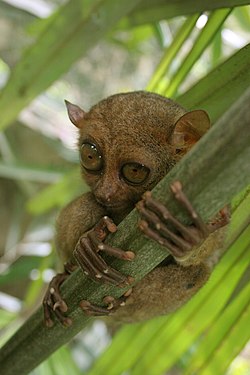family of mammals From Wikipedia, the free encyclopedia
The tarsiers are prosimian (non-monkey) primates. They got their name from the long bones in their feet. They are now placed together with the simians (monkeys).
| Tarsiers | |
|---|---|
 | |
| Philippine tarsier (Carlito syrichta) | |
| Scientific classification | |
| Kingdom: | |
| Phylum: | |
| Class: | |
| Order: | |
| Suborder: | |
| Infraorder: | Tarsiiformes Gregory, 1915 |
| Family: | Tarsiidae Gray, 1825 |
| Genera | |
|
Carlito | |
They live in trees, and are entirely nocturnal. Tarsiers are the only primates which are wholly carnivorous. They mainly eat insects, but some are also known to eat birds and snakes. Tarsiers can catch prey like birds even if they are in motion as the tarsiers jump from tree to tree to catch their prey.[1]
Tarsiers have incredibly good hearing.[2]
They have large eyes. Each is about 16 mm wide.They are very sensitive to touch, and weigh as much as their entire brain.[3] Unlike many nocturnal animals, tarsiers lack a light-reflecting area (tapetum lucidum) of the eye. They also have a fovea, which is also not usual in nocturnal animals.
The tarsier's brain is different from other primates in one respect. The sequence of cell layers in the lateral geniculate nucleus getting information from both eyes is different from the set-up in lemurs, lorises, and monkeys.[4] "This apparent difference distinguishes tarsiers from all other primates, and reinforces the view that they arose in an early, independent line of primate evolution".[5]
Pregnancy takes about six months, which is a long time for such a small animal.[6] Tarsiers give birth to single offspring.
They were once widespread, but now tarsiers live only on islands in south-east Asia. Fossils are found in Asia, Europe, and North America, and some disputed fossils from Africa. Living tarsiers are on several southeast Asian islands, including the Philippines, Sulawesi, Borneo, and Sumatra.
They also have the longest continuous fossil record of any primate. The fossil record shows that their teeth have not changed much, except in size, in the past 45 million years. That means what they eat, and probably their lifestyle, has not changed much, either.[1]
Tarsiers are said to be the inspiration for the famous movie character Yoda of Star Wars due to their small size but excellent hunting skills.
One tarsier species, Dian's tarsier (Tarsius dentatus), is listed by on the IUCN Red List as being "lower risk – conservation dependent". Horsfield's tarsier (Cephalopachus bancanus) is listed as "lower risk – least concern". The spectral tarsier (Tarsius spectrum) is categorized as "lower risk, not threatened". The pygmy tarsier (Tarsius pumilus) was thought to be extinct until a family were found in 2008.[7][8] The two males and single female (a fourth escaped) were captured using nets, and were radio collared to track their movements. Other tarsier species are listed as "data deficient".
Seamless Wikipedia browsing. On steroids.
Every time you click a link to Wikipedia, Wiktionary or Wikiquote in your browser's search results, it will show the modern Wikiwand interface.
Wikiwand extension is a five stars, simple, with minimum permission required to keep your browsing private, safe and transparent.